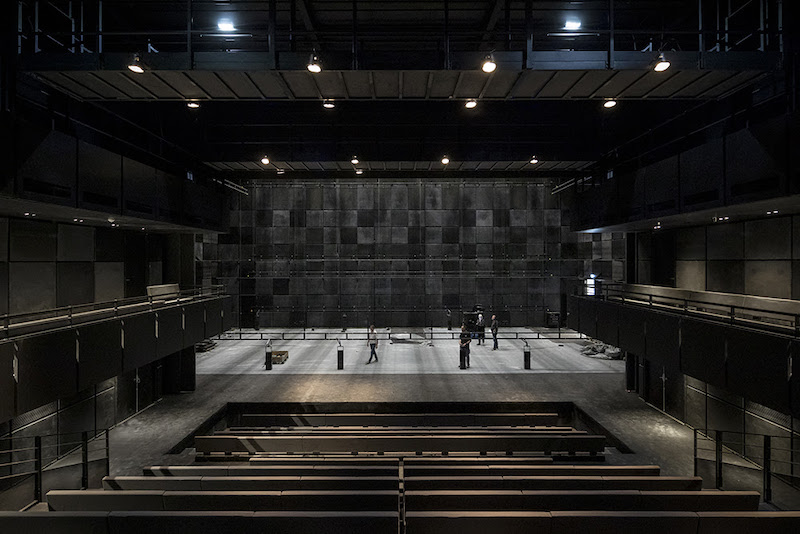The new 18,000-sm Maison de l’Économie Créative et de la Culture en Aquitaine, or MÉCA, brings together FRAC for contemporary art, ALCA for cinema, literature, and audiovisuals, and OARA for performing arts, into one cultural loop. BIG and FREAKS freearchitects were selected to design the art and culture building back in 2012.
A series of steps and ramps leads from the pavement of the promenade, passed the façade that provides glimpses into the stage towers of OARA and the offices of ALCA, and into the 1,100-sm outdoor urban room at MÉCA’s core. During special occasions, the outdoor urban room (and other outdoor spaces) can be turned into a stage for concerts and theatrical performances, or an extended gallery for sculptures and other art installations. The façade comprises 4,800 prefabricated concrete panels interspersed with windows of various sizes to control the amount of light entering inside. The 1.6-ton concrete slabs are sandblasted to expose their raw qualities and to texture the surface with the local sandstone of Bordeaux.

When visitors enter MÉCA from the ground floor, they will be met with a lobby where they can relax in the spiral pit or dine at Le CREM, a restaurant furnished with red furniture and cork chairs, a reference to the wine the city is known for. Near the restaurant, a giant periscope allows visitors to see the activity in the outdoor urban room and vice-versa.

Also on the ground floor is OARA’s 250-seat theater. It features flexible seating configurations and acoustic systems optimized by an all-black checkerboard panel of concrete, wood, and perforated metal. On the second floor is an 80-seat, red-accented cinema and two production offices and project incubation areas. FRAC occupies the upper floors. These spaces include seven-meter-high exhibition spaces, production studios for artists, storage facilities, and a 90-seat auditorium and café.
Topping off the entire building is an 850-sm public roof terrace. The terrace serves as an extension of the exhibitions spaces and provides space for large-scale art installations and outdoor performances.





Related Stories
| Oct 13, 2010
Residences bring students, faculty together in the Middle East
A new residence complex is in design for United Arab Emirates University in Al Ain, UAE, near Abu Dhabi. Plans for the 120-acre mixed-use development include 710 clustered townhomes and apartments for students and faculty and common areas for community activities.
| Oct 13, 2010
Community center under way in NYC seeks LEED Platinum
A curving, 550-foot-long glass arcade dubbed the “Wall of Light” is the standout architectural and sustainable feature of the Battery Park City Community Center, a 60,000-sf complex located in a two-tower residential Lower Manhattan complex. Hanrahan Meyers Architects designed the glass arcade to act as a passive energy system, bringing natural light into all interior spaces.
| Oct 13, 2010
Bookworms in Silver Spring getting new library
The residents of Silver Spring, Md., will soon have a new 112,000-sf library. The project is aiming for LEED Silver certification.
| Oct 12, 2010
Holton Career and Resource Center, Durham, N.C.
27th Annual Reconstruction Awards—Special Recognition. Early in the current decade, violence within the community of Northeast Central Durham, N.C., escalated to the point where school safety officers at Holton Junior High School feared for their own safety. The school eventually closed and the property sat vacant for five years.
| Oct 12, 2010
Richmond CenterStage, Richmond, Va.
27th Annual Reconstruction Awards—Bronze Award. The Richmond CenterStage opened in 1928 in the Virginia capital as a grand movie palace named Loew’s Theatre. It was reinvented in 1983 as a performing arts center known as Carpenter Theatre and hobbled along until 2004, when the crumbling venue was mercifully shuttered.
| Oct 12, 2010
Gartner Auditorium, Cleveland Museum of Art
27th Annual Reconstruction Awards—Silver Award. Gartner Auditorium was originally designed by Marcel Breuer and completed, in 1971, as part of his Education Wing at the Cleveland Museum of Art. Despite that lofty provenance, the Gartner was never a perfect music venue.
| Oct 12, 2010
The Watch Factory, Waltham, Mass.
27th Annual Reconstruction Awards — Gold Award. When the Boston Watch Company opened its factory in 1854 on the banks of the Charles River in Waltham, Mass., the area was far enough away from the dust, dirt, and grime of Boston to safely assemble delicate watch parts.
| Oct 12, 2010
Cuyahoga County Soldiers’ and Sailors’ Monument, Cleveland, Ohio
27th Annual Reconstruction Awards—Gold Award. The Cuyahoga County Soldiers’ and Sailors’ Monument was dedicated on the Fourth of July, 1894, to honor the memory of the more than 9,000 Cuyahoga County veterans of the Civil War.
| Oct 12, 2010
Building 13 Naval Station, Great Lakes, Ill.
27th Annual Reconstruction Awards—Gold Award. Designed by Chicago architect Jarvis Hunt and constructed in 1903, Building 13 is one of 39 structures within the Great Lakes Historic District at Naval Station Great Lakes, Ill.
| Oct 12, 2010
From ‘Plain Box’ to Community Asset
The Mid-Ohio Foodbank helps provide 55,000 meals a day to the hungry. Who would guess that it was once a nondescript mattress factory?

















